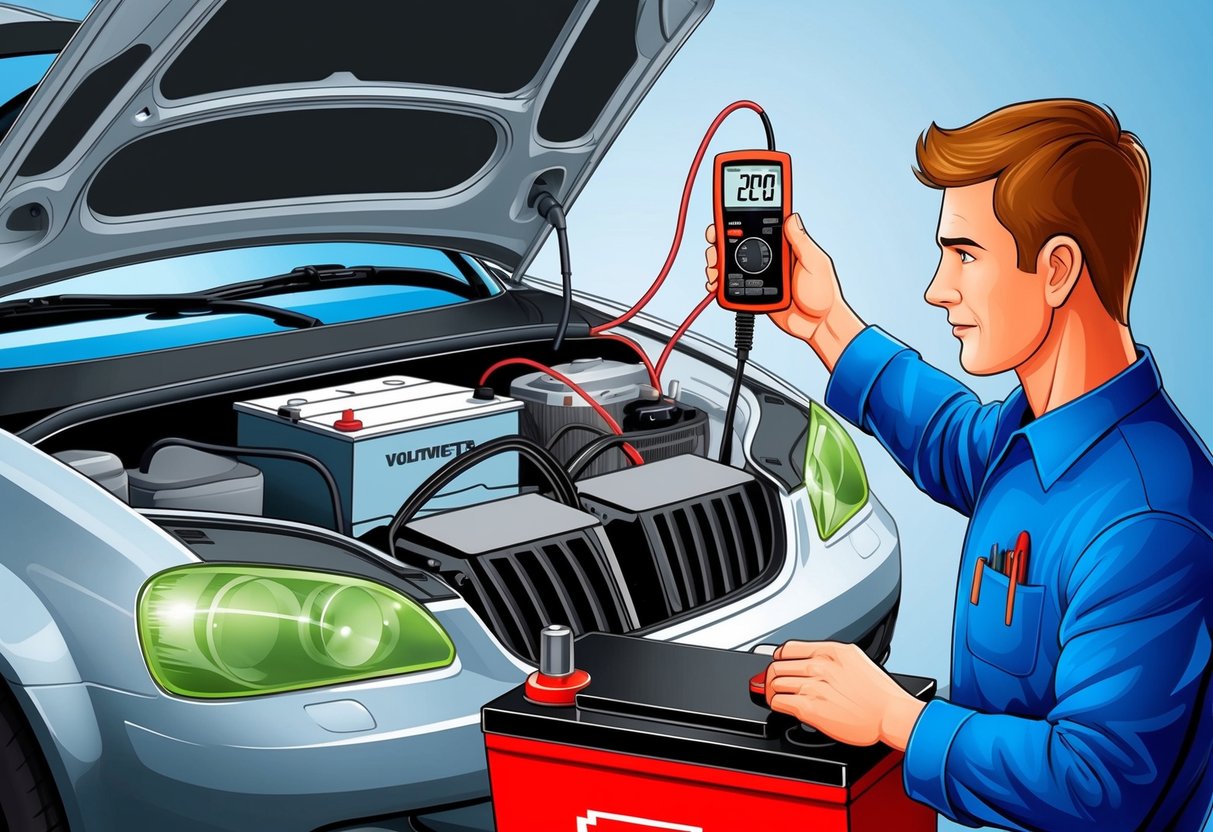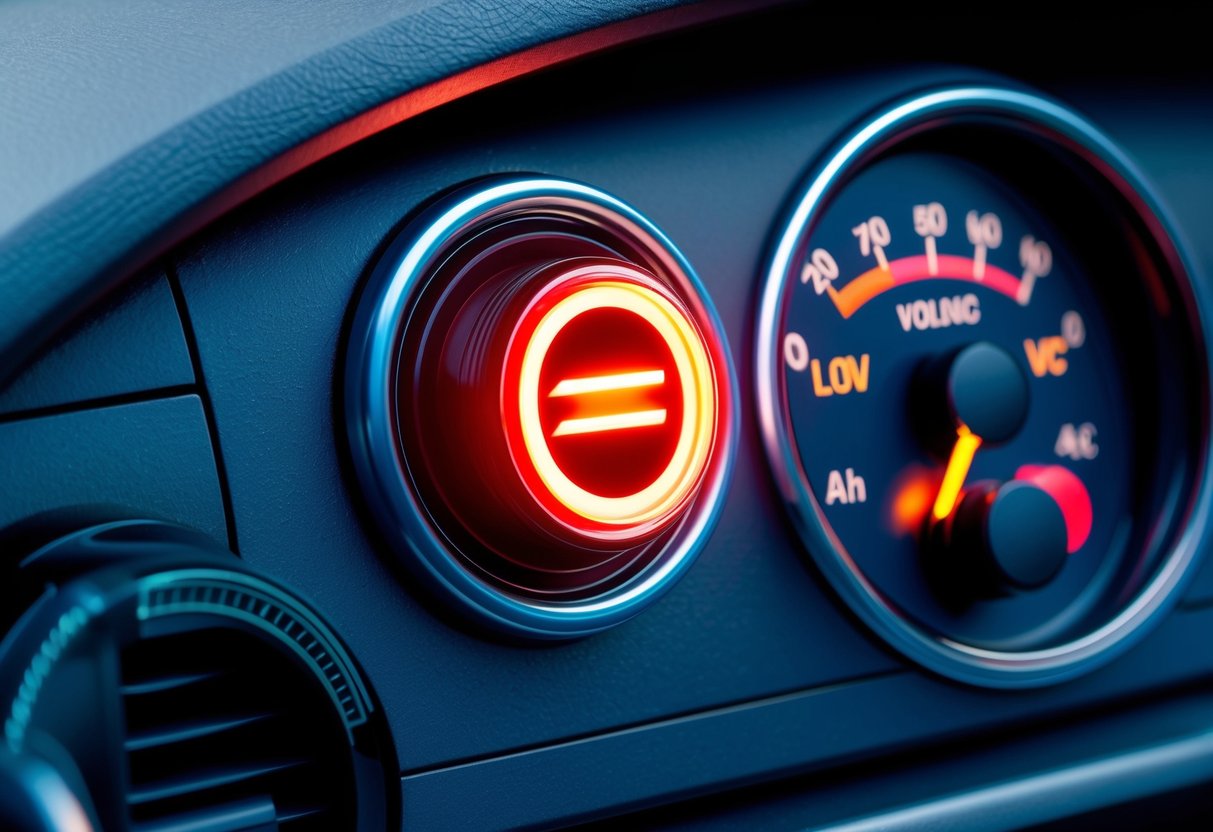
Check Engine or Battery Warning Light
Modern vehicles are equipped with a dashboard warning light for the battery or charging system. When this light appears, it indicates a potential problem that needs attention.
It may say “battery,” show a battery icon, or flash as a check engine light. This warning could mean the battery is weak, the alternator isn’t charging, or there’s an electrical fault.
Even if the car starts normally, the light shouldn’t be ignored, as underlying charging issues can lead to a dead battery and electrical failures. A persistent warning light is a strong sign to have both the battery and charging system inspected by a professional.
Early diagnosis can prevent further issues. For more on this sign, refer to tips in the Bridgestone guide on battery replacement.
Dimming Headlights and Electrical Issues
Dimming headlights are one of the most recognized signs of a failing car battery. Headlights that appear noticeably dimmer than usual or flicker, especially when the engine is idling or starting, indicate power issues.
Other electrical components—like power windows, dashboard lights, or the radio—may also function erratically or lose power. These symptoms happen because a deteriorating battery cannot provide consistent voltage to the vehicle’s accessories.
Electrical performance problems can worsen over time and may eventually prevent the car from starting at all. Regularly observing dimming headlights and inconsistent electronics should prompt battery testing.
Details can be found on the Halfords blog about battery replacement signals.
Battery Case Looks Swollen or Leaking
Visual inspection of the battery can reveal serious issues. A battery case that’s visibly swollen, bulging, or deformed often means it’s overheated or suffering from internal failure.
This can occur after exposure to excessive heat or freezing conditions. Leaking battery acid is another clear sign the battery should be replaced immediately.
Acid leaks can damage surrounding components, corrode terminals, and reduce battery performance. White or blue powder near the terminals signals corrosion due to leaking acid.
Swelling, cracking, or leakage is not repairable and indicates the battery is unsafe to use. Replacement should be completed as soon as possible to avoid greater electrical system damage or breakdown.
Steps to check for these conditions are described at HTSaves’ car battery FAQ.
Physical Symptoms of a Failing Battery
A car battery that is close to failing often shows clear physical warning signs. Being able to spot these issues in time can help prevent the inconvenience and cost of a sudden breakdown.
Corrosion on Battery Terminals
Corrosion buildup is a common and visible symptom of car battery trouble. This appears as a white, blue, or greenish residue around the battery terminals and cable ends.
Corrosion can restrict the connection between the battery and the car’s electrical system, leading to starting issues and unpredictable performance. Common causes include exposure to battery acid fumes and normal chemical reactions within the battery.
Over time, this residue can become thick enough to block electrical flow, causing slow cranking or making the car not start at all. Regular inspection and cleaning of the terminals are important to help avoid further damage.
Drivers who find heavy terminal corrosion should consider replacing the battery, especially if cleaning does not resolve the problem. Addressing corrosion early can extend the lifespan of the battery and maintain reliable vehicle operation.
Unusual Odors from the Battery
A strong rotten egg smell from the battery compartment signals a potential battery failure. This odor comes from leaking sulfuric acid or the release of hydrogen sulfide gas, both of which indicate internal damage or overcharging.
Detecting these odors means action should be taken immediately. Leaking chemicals may lead to corrosion on other engine components or pose a safety risk.
Prolonged exposure to battery leaks can also damage electrical wiring and connectors nearby. Drivers who notice unusual odors while inspecting their battery should avoid contact with the fluid and seek replacement.
Addressing a leaking or gassing battery immediately reduces the risk of further harm to the vehicle and ensures the car’s electrical system remains intact. A leaking battery should be replaced as soon as possible to prevent further issues.
Electrical System Warning Signs

Electrical symptoms are often the first indicators that a car battery may be failing. Paying close attention to how electrical accessories behave can help drivers detect battery issues before they lead to more serious problems.
Malfunctioning Power Accessories
When a car battery starts to weaken, power accessories such as windows, locks, and seats may operate more slowly or fail to respond properly. If a driver notices unusually slow-moving power windows, sluggish seat motors, or inconsistent operation of the radio and climate controls, it often points to insufficient battery power.
In many newer vehicles, the battery plays a critical role in supporting advanced electronic features and modules. Sometimes, the central locking system, navigation screen, or heated seat functions may cut out for brief periods or reset unexpectedly.
Even intermittently failing chargers for mobile devices or USB ports signal that the battery may not be delivering stable voltage. If these symptoms persist, testing the battery is advised, as these issues can worsen and leave the driver stranded.
Flickering Dashboard Lights
Dashboard warning lights that flicker when starting the engine or while idling are a common early sign of a weak or failing battery. Flickering or dimming dashboard lights, instrument cluster displays, or warning indicators like the “battery” or “check engine” light should not be ignored.
Dimming headlights and interior lights often accompany this issue, indicating that the battery can no longer provide consistent voltage to all vehicle systems. These problems become more noticeable in cold weather or after the vehicle has been parked for an extended period.
For more information on how dashboard lights and dimming headlights relate to battery health, regular inspection and prompt replacement of an aging battery can prevent electrical failures and ensure reliable vehicle operation.